I’m getting ready to install several electric gizmos on my Honda Pacific Coast. To prepare I decided to install an auxiliary fuse block. The local marine supply shop happened to have a Blue Sea Systems ST Blade Fuse Block (PN: 5025). I bought it and brought it home. This specific unit has both a positive and a negative block. The negative is simply a large grounding plate while the positive side has six independent fuses. On several websites I have seen people using various Blue Sea Systems fuse blocks.
Safety Warning: I’m sure I don’t have to tell you but anything you do or don’t do due to this page, the photos on the page, the text, or anything else that in any way involves me is done at your own risk. Doing these modifications voids any and all warranties on any and all devices that you own. This can be a fire hazard, can cause death and dismemberment, can make your significant other leave you, and might make you become an alcoholic. This worked for me but might not work for you. Your mileage may vary. Proceed at your own risk!
Synopsis: I sawed a fuse block in half, applied liberal quantities of silicon RTV, and stuck the two halves into the trunk of my bike. It’s not super pretty but it works and was done with the parts I had on hand. You will need a Blue Sea Systems fuse block P/N 5025. It costs about $40. You will also need silicon RTV, extra blade fuses, 14 gauge or larger wire to run between the battery and the fuse block (2 or 3 feet of black and of red), an automotive relay and wire harness (under $20 at your local auto parts store) if you want the power to be killed while your bike is off, various miscellaneous connectors and splices, and a hack saw. A flat file is optional.
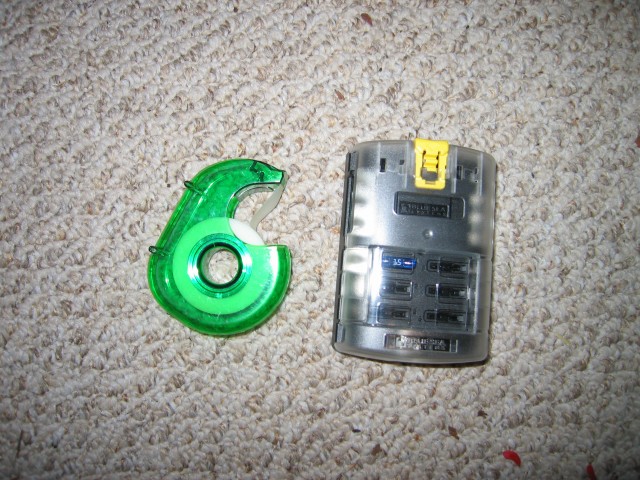
This is the unit straight out of the packaging. It comes with one 15 amp fuse and a plastic cover. I put a roll of tape next to it for size comparison. Ignore the red bits of wire insulation in the photo. My Roomba is going to be very busy vacuuming those bits up!
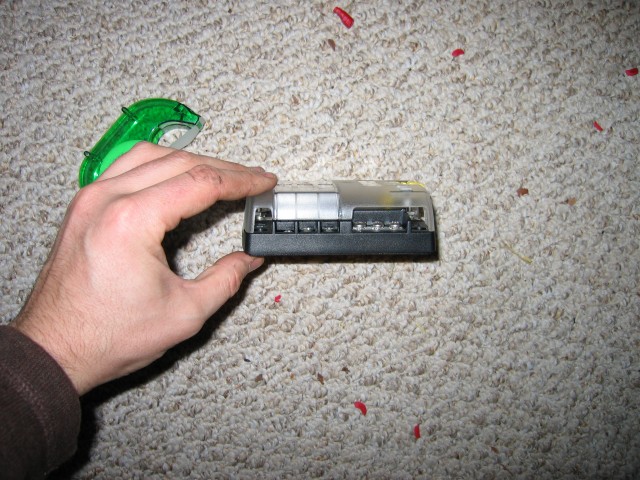
From the side. The right three screws are for ground wires while the left three are fused. This is mirrored on the other side. The wires that feed the positive and negative buses come in at the ends of the unit. With the plastic cover on, each feed wire can be placed either right, left, or straight out from the unit.
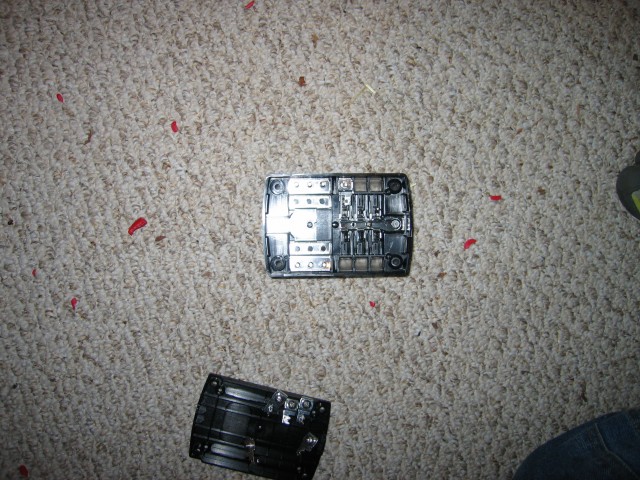
Being inquisitive, I took the unit apart to see what was inside. As you can see, the ground side (left) is just a big piece of metal (copper coated in tin or something along those lines that doesn’t rust in salt air). The right side contains the fuse blocks and is individually isolated. Being segregated into two sides like this will become important in another few photos.
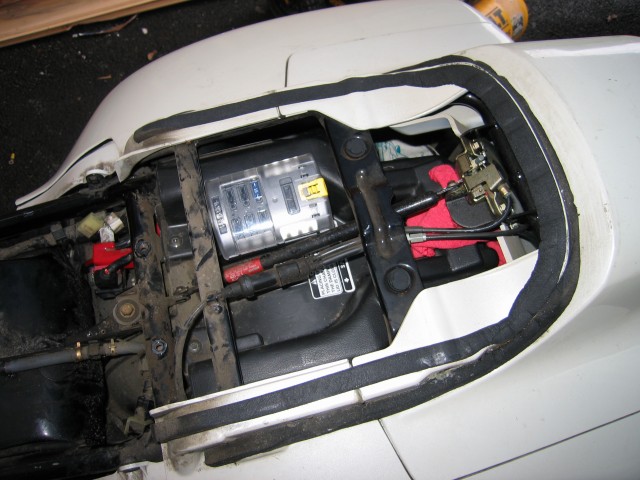
After looking around for a happy place to mount the fuse panel on the bike I decided to put it in the trunk area. Everywhere else I looked I either already had something, it wouldn’t fit, or I would never be able to change a fuse.
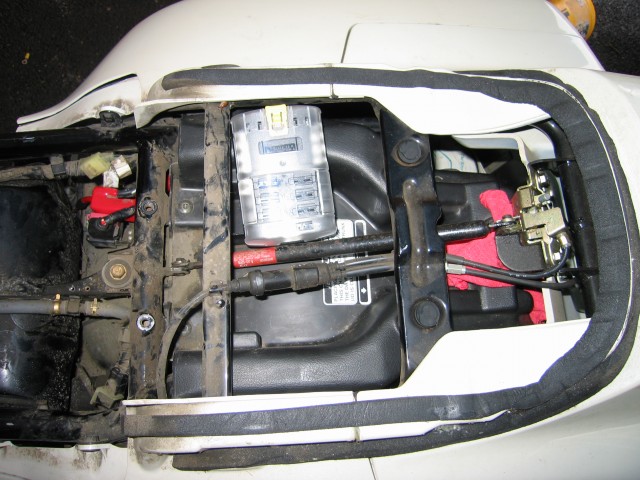
Hmm it doesn’t fit. However, looking at it in this position gave me an idea. What if I cut it in half and split the two sides on either side of the gas spring for the trunk lid? This looks like a good afternoon project!
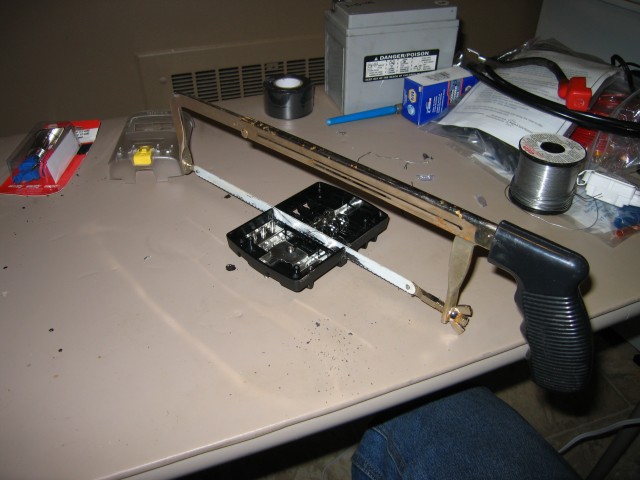
This poor table sure does take a beating. Yesterday I was soldering on it. Today I’m using a hacksaw. If my ex knew what would happen to it, she probably would have never let me borrow the table!
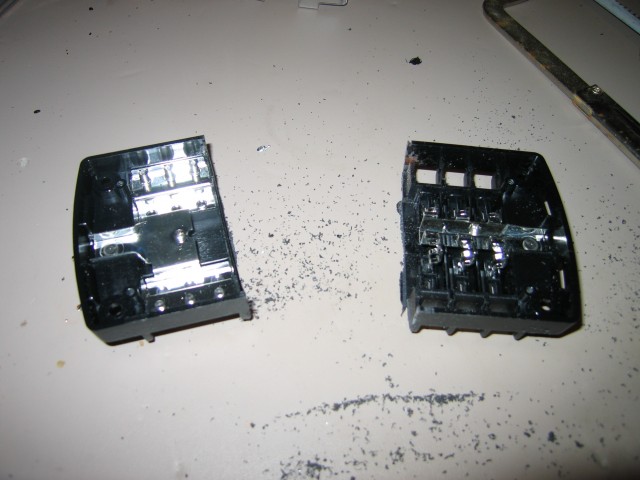
I cut down the center where there happened to be a natural saw-guide molded into the plastic. Pretty sure this voided my warranty and means I can’t return it if I decide I don’t like it.
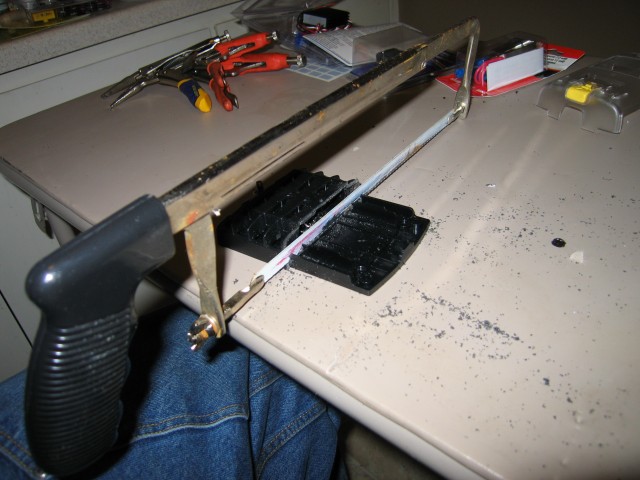
Cutting the bottom in twain. Without the bottom, the fused terminals wouldn’t stay put. Again there is a convenient set of guides to keep the saw going straight and true.
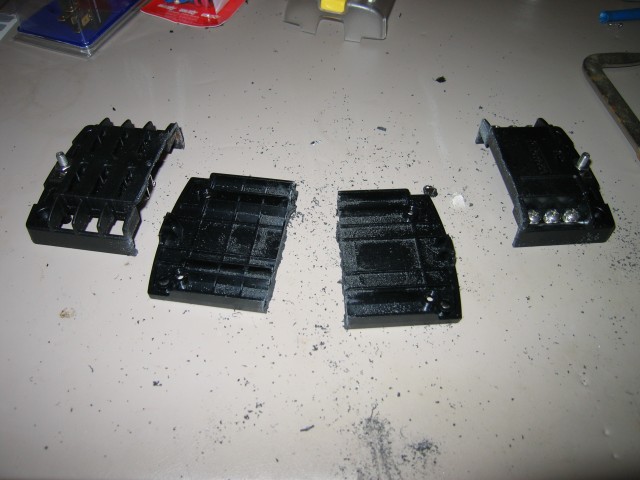
All the pieces cut apart.

I used a flat file to clean it up a little bit. If you aren’t bothered by rough edges, this step can be skipped. The only reason I did it was I figured I might want to sell this motorcycle someday in the distant future.
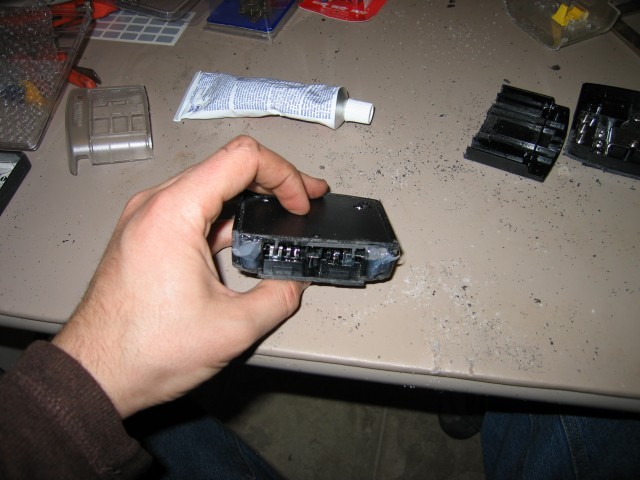
Next stop, Silicon RTV city! In case water ever gets in and tries to muck things up or some insects decide they need a warm little nest I decided to block up the cut ends of the two sides of the fuse block.
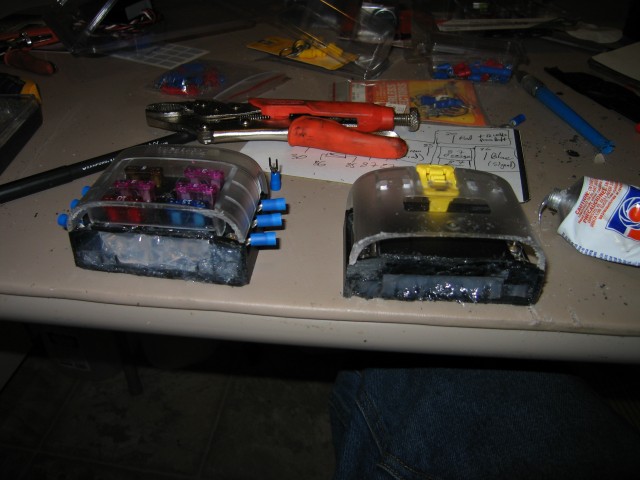
Lots of RTV filling up the spaces. I made sure to not inject the RTV in far enough to come in contact with the terminals. If that RTV got into the fuse blocks, they might not work correctly.
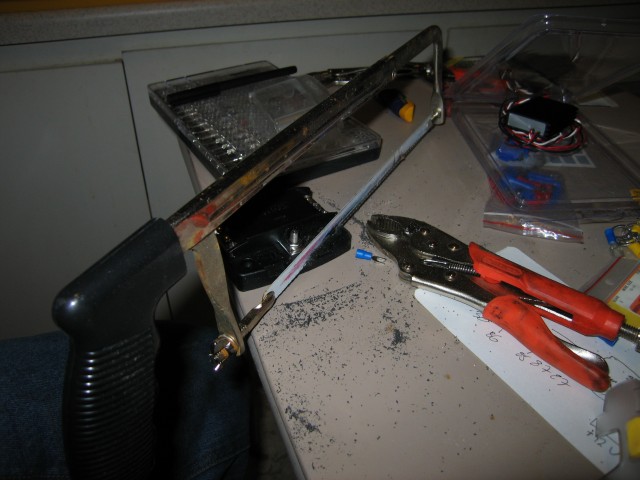
I did a test fit and found that the two halves still didn’t quite fit. Back to the hack saw! This time I trimmed off the corner on the negative buss block. The fused buss block required having the whole front edge hacksawed off. For some reason I didn’t take a picture of it. If you happen to actually try doing this crazy mod, do a few test fits and you’ll figure out what to do.
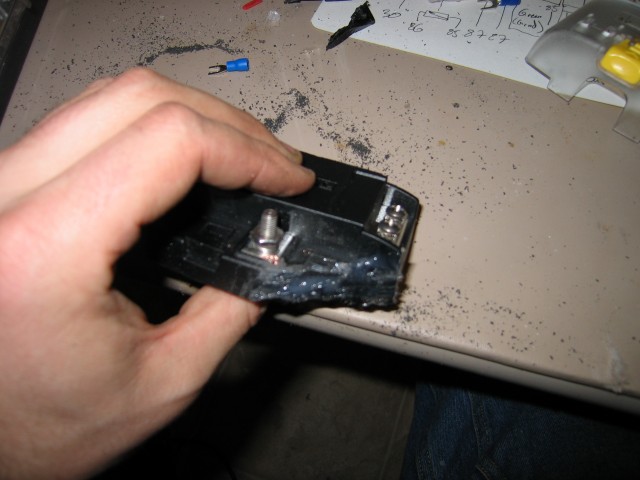
More RTV to keep the buggies out.
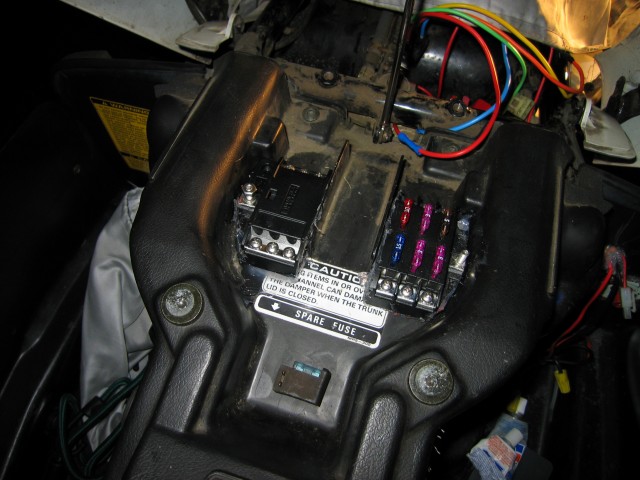
Fitting the two halves into the trunk compartment. I used a LOT of RTV to attach the buss block and fuse panel to the trunk plastic. You might want to use screws or some other form of adhesive. I just happened to have a tube of RTV at my disposal and wasn’t afraid to use it.
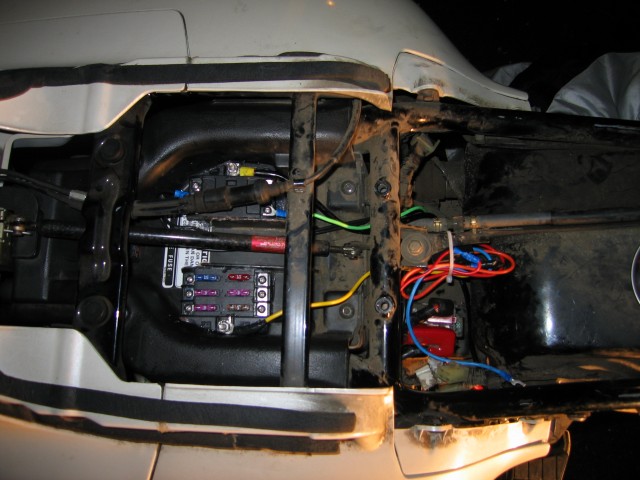
Looking down at the finished install with the trunk closed and the passenger seat removed for a better view. Both halves of the fuse block fit snugly on either side of the gas shock. I am running wires between the frame and the wheel well/fender plastic. My messy wiring and relay are zip-tied to the piece of metal that attaches between the frame and the gas tank. I purchased a cheap automotive relay and harness from the local auto parts store. Any auto parts store will have one for under $20. The fuse block has a fuse between it and the battery. It’s located down by the battery and is accessible when the trunk is open. I put a 30 amp fuse on the entire auxiliary fuse block because of the size of the wire I used and because if I’m using that much, I have a big, big problem.
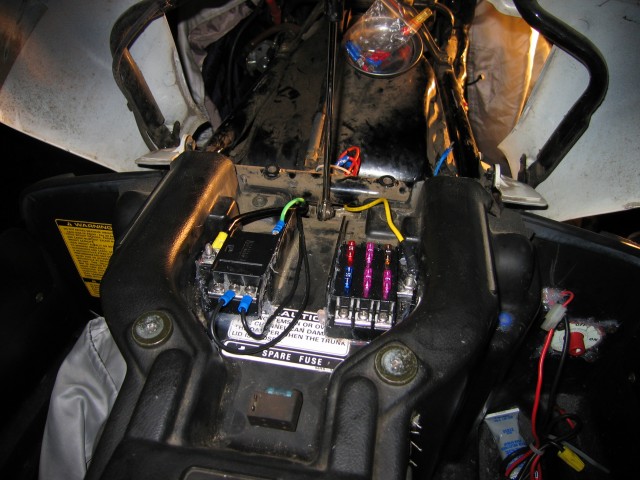
One final view of the completed installation. The wiring hadn’t been tidied up in this picture yet. It looks marginally neater now. All in all I am very happy with this modification. The only downside is that you lose the protective plastic cover. But with the trunk closed I’m not too worried about water dripping or splashing into the space. My passenger and driver seat both have plastic wrap installed to prevent leaks.
If you find these photos useful, do it yourself, have questions, or anything else, please drop me a comment below! Send me some photos of how you installed yours and I’ll put them on this page. And remember, YMMV.
